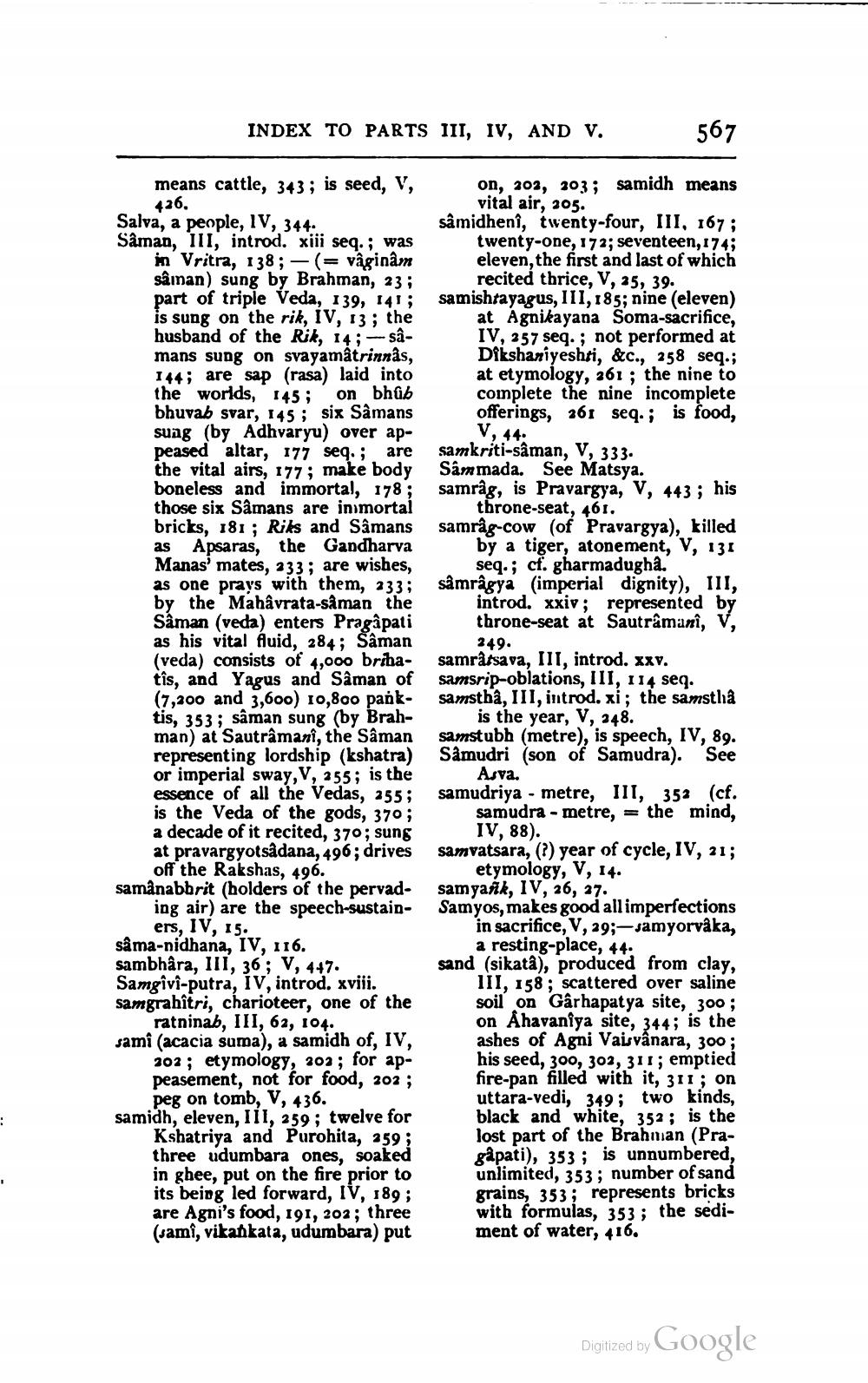________________
INDEX TO PARTS III, IV, AND V.
567
on, 302, 303; samidh means
vital air, 205. sâmidhenî, twenty-four, III, 167;
twenty-one, 172; seventeen, 174; eleven, the first and last of which
recited thrice, V, 25, 39. samishtayagus, III, 185; nine (eleven)
at Agnikayana Soma-sacrifice, IV, 257 seg. ; not performed at Dikshaniyeshti, &c., 258 seq.; at etymology, 261; the nine to complete the nine incomplete offerings, 261 seq.; is food,
V, 44:
means cattle, 343; is seed, V,
426. Salva, a people, IV, 344 Sâman, ill, introd. xiii seq. ; was
in Vritra, 138;-(= vàginam sâman) sung by Brahman, 23; part of triple Veda, 139, 141; is sung on the rik, IV, 13; the husband of the Rik, 14; -samans sung on svayamâtrinnas, 144; are sap (rasa) laid into the worlds, 145; on bhab bhuvab svar, 145 ; six Sâmans sung (by Adhvaryu) over appeased altar, 177 seq.; are the vital airs, 177; make body boneless and immortal, 178; those six Samans are in mortal bricks, 181; Riks and Samans as Apsaras, the Gandharva Manas' mates, 233; are wishes, as one prays with them, 233; by the Mahâvrata-saman the Såman (veda) enters Pragâ pati as his vital fluid, 284; Saman (veda) consists of 4,000 briha- tîs, and Yagus and Saman of (7,200 and 3,600) 10,800 paiktis, 353; saman sung (by Brahman) at Sautrâmani, the Sâman representing lordship (kshatra) or imperial sway, V, 255; is the essence of all the Vedas, 255; is the Veda of the gods, 370; a decade of it recited, 370; sung at pravargyotsådana, 496; drives
off the Rakshas, 496. samanabbrit (holders of the pervad-
ing air) are the speech-sustain-
ers, IV, 15. sama-nidhana, IV, 116. sambhâra, III, 36; V, 447. Samgivi-putra, IV, introd. xviii. samgrahîtri, charioteer, one of the
ratninab, III, 62, 104. sami (acacia suma), a samidh of, IV,
302; etymology, 302; for appeasement, not for food, 202 ;
peg on tomb, V, 436. samidh, eleven, III, 259; twelve for
Kshatriya and Purohita, 259; three udumbara ones, soaked in ghee, put on the fire prior to its being led forward, IV, 189; are Agni's food, 191, 202; three (Jami, vikankata, udumbara) put
samkriti-sâman, V, 333. Sammada. See Matsya. samråg, is Pravargya, V, 443 ; his
throne-seat, 461. samråg-cow (of Pravargya), killed
by a tiger, atonement, V, 131
seq.; cf. gharmadugha. sâmragya imperial dignity), III,
introd. xxiv; represented by throne-seat at Sautrâmani, V,
249. samratsava, III, introd. xxv. samsrip-oblations, III, 114 seg. samstbâ, III, introd. xi; the samstha
is the year, V, 348. samstubh (metre), is speech, IV, 89. Samudri (son of Samudra). See
Asva. samudriya - metre, III, 352 (cf.
samudra - metre, = the mind,
IV, 88). samvatsara, (?) year of cycle, IV, 21;
etymology, V, 14. samyank, IV, 26, 27. Samyos, makes good all imperfections
in sacrifice, V, 29;-samyorvaka,
a resting-place, 44. sand (sikatâ), produced from clay,
III, 158; scattered over saline soil on Garhapatya site, 300 ; on Ahavaniya site, 344; is the ashes of Agni Vaisvanara, 300; his seed, 300, 302, 311; emptied fire-pan filled with it, 311 ; on uttara-vedi, 349; two kinds, black and white, 352; is the lost part of the Brahman (Pragâpati), 353; is unnumbered, unlimited, 353; number of sand grains, 353; represents bricks with formulas, 353; the sediment of water, 416.
Digitized by Google




